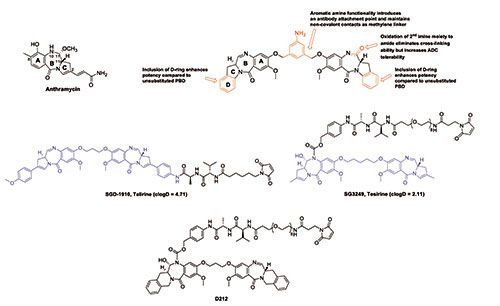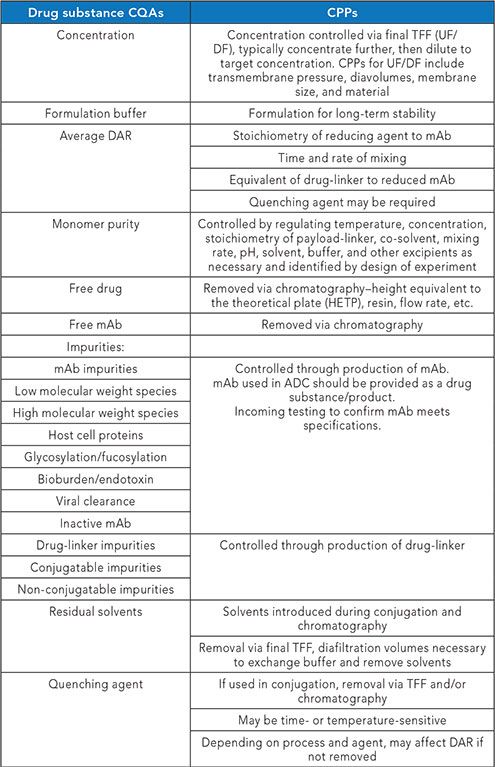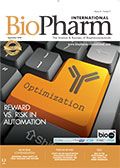QbD in the Development of ADCs with PBD Dimer Warheads
The development and optimization of an efficient conjugation process involves identifying the critical quality attributes and monitoring critical process parameters.
Juan Gaertner/Shutterstock.com

In the quest for treating diseases, pharmaceutical and biotechnological organizations are constantly in pursuit of novel technologies. The technology for linking drugs or chemical compounds to antibodies has been known for decades, but the approach to treat diseases, especially cancer, by using antibody drug conjugates (ADCs) has gained recent momentum. Cytotoxins that are otherwise not “druggable” can be tethered to antibodies and safely delivered to the desired intracellular target. There are currently four ADCs on the market in which cytotoxins, such as auristatins (Adcetris [brentuximab vedotin], approved in 2011), maytansinoids (Kadcyla [ado-trastuzumab emtansine], approved in 2013), and calicheamicins (Mylotarg [gemtuzumab ozagamicin], reintroduced in 2017; and Besponsa [inotuzumab ozagamicin]; approved in 2017), have been linked to different monoclonal antibodies (mAbs) successfully. The cytotoxins, once released inside the cell, elicit their activity by either inhibiting tubulin or binding to the DNA minor groove causing subsequent DNA strand breaks, thereby resulting in apoptosis. Among the aforementioned cytotoxins, monomethyl auristatin ‘E’ (MMAE)-based ADCs are the most investigated clinically (1). However, the marketed cytotoxins are known to face multidrug resistance and, therefore, there is a constant search for novel payloads with previously unexplored mechanism of action-pyrrolobenzodiazepines (PBDs) fit the profile.
The discovery of anthramycin, a natural PBD, was published (2, 3) in the early 1960s. A number of synthetic PBDs have been developed and studied for their antitumor properties ever since. They have been known to elicit their activity by binding selectively to guanine rich sequences in the DNA minor-groove. PBDs contain a substituted aromatic ring-A, a diazepine ring-B, and a pyrrolidine ring-C with an S-chiral center positioned between the B and C rings (see Figure 1). They possess an imine functionality at N10-C11 that provides an avenue for the covalent linkage to guanine bases after appropriate positioning in the minor groove. PBDs are known to be one of the most potent among payload classes, and their activity ranges from low nanomolar to picomolar cytotoxicity (4). Two monomeric PBD units can be joined together as shown for talirine or tesirine (Figure 1), and the unique structure of the resultant PBD dimer contains two alkylating imine functionalities that allows for both inter-strand and intra-strand DNA crosslinking, thereby increasing the potency of the compound by at least two-logarithmic units. Substitution of the pyrrolidine ring by an indoline ring, such as the one shown in Figure 1, has been known to result in further increase in activity. More recently, details on the preparation and activities of modified PBD dimers that contain a tetrahydroisoquinoline (THIQ) ring system, also known as isoquinolidinobenzodiazepine (IQB) dimers, have been revealed (5–8). These compounds are so potent that, if and when they are cleaved from the antibody and linker and released prematurely while in circulation, they result in undesired toxic side effects, including death of patients (9, 10). This issue presents a major problem in the development of novel ADCs.
CLICK TO ENLARGE IMAGE Figure 1: Structures of anthramycin, pyrrolobenzodiazepine (PBD) dimers talirine and tesirine, an indolinobenzodiazepine derivative, and D212, an isoquinolidinobenzodiazepine dimer. ADC is antibody drug conjugate [all figures courtesy of the authors].

The development of PBD dimers
PBD dimers are, therefore, grouped among the most potent payloads known and are extremely hydrophobic in nature. Due to this nature, the PBD dimers intended to be part of an ADC typically contain appropriate hydrophilic moieties that make the payload amenable during the aqueous-based conjugation process. These hydrophilic groups also significantly reduce the resultant conjugate’s propensity to aggregate during and after conjugation.
The development of PBD dimers itself is complicated by the fact that the dimer contains two stereocenters (one from each monomer unit), and the synthesis of novel analogues involves multiple steps. The conditions used to prepare the target molecule should be amenable so that racemization during any of these synthetic steps can be avoided. For example, the preparation of tesirine reported in the literature involves 19 steps, in which the monomer unit is formed after the 12th step and involves coupling of an enantiomerically pure proline derivative in step five itself (11).
Due to the presence of chiral center(s) in PBDs (and PBD dimers), efforts have to be dedicated upfront during the process development stages in developing robust in-process as well as analytical tools, not only to monitor the progress of the reaction and formation of by-products, but also to assess the purity, including chiral purity, of the intermediates formed after each step as well as the final product. Even if the synthesis involves enantiomerically pure starting materials, if the conditions adopted are such that isomerization occurs during one of the steps, then the resultant product may potentially contain at least a mixture of four compounds (with two chiral centers) in different ratios. Appropriate purification methodologies should, therefore, be developed and optimized to efficiently separate the different isomers. Alternatively, significant time and effort must be dedicated in developing the appropriate reaction conditions.
One of the major issues with the development of novel payload linkers, such as PBD dimers and derivatives of known cytotoxins for ADCs, is the hydrophobicity of the compounds and as discussed, the product typically incorporates hydrophilic functionalities such as polyethylene glycol (PEG) linkers of varying sizes and/or other amino acids to facilitate the conjugation process, which is typically carried out in buffered aqueous systems. Because these functionalities are deliberately built in to increase the hydrophilicity of the molecule, the target compounds often are not crystalline and are usually purified by chromatographic purification methodologies, especially by reversed phase purifications that typically involve elution of the target compound using a mixture of an organic solvent (e.g., acetonitrile) in water. The purified fractions obtained are often lyophilized/freeze-dried. The freeze-drying operation itself will need significant process development and optimization, meaning these efforts add to the overall time and associated costs. Even if the target compounds are purified via crystallization, the potency of these cytotoxins or their derivatives are such that they require appropriately designed equipment to limit exposure to the personnel involved; development and optimization of the crystallization conditions also has associated costs and time. Crystallization of the target compounds will further involve filtration and drying operations.
The development and optimization of the processes depends on the eventual scale of manufacture, which in turn depends on the following:
- The phase of the clinical study that the material is intended for-early phases will require less drug product (12).
- The potency of the cytotoxin-the higher the potency of the drug, the less the amount required.
- The subsequent conjugation process-stochastic cysteine or lysine-based conjugations with an average drug-to-antibody ratio (DAR) specification of four to eight require more amount of the drug, while THIOmAb or engineered cysteine-based conjugations require significantly less.
As previously mentioned, PBD dimers and other cytotoxins are highly potent compounds that require specific handling requirements including appropriate engineering controls, safety controls, administrative controls, and other safety measures, such as having an in-house team trained in emergency spill response. In addition, the development and optimization of adequate cleaning procedures and a cleaning verification program for each cytotoxin being manufactured to ensure no cross-contamination between different batches are crucial challenges that involve personnel from different departments, such as R&D, process development, manufacturing, analytical, and quality assurance (QA). The cleaning verification program depends on the sampling technique, which in turn depends on the availability of appropriate coupons and on the stability of the compound as well.
Identifying CQAs and CPPs
Subsequent to the successful development and optimization of the process for the preparation of the payload-linker, efforts must be dedicated in the development and optimization of an efficient conjugation process that involves identification of critical quality attributes (CQAs). A typical flow diagram of a conjugation process is given in Figure 2. Each of the analytically traceable key indicators of a product’s quality in turn depends on key parameters called the critical process parameters (CPPs), which are controlled by different means. A list of the CQAs and associated CPPs are given in Table I.
Figure 2: Typical flow diagram of a conjugation process. mAb is monoclonal antibody. TCEP is tris(2-carboxyethyl)phosphine. DTT is dithiothreitol. TFF is tangential flow filtration. HIC is hydrophobic interaction chromatography. DS is drug substance.

Table I: Critical quality attributes (CQAs) and associated critical process parameters (CPPs) of an antibody-drug conjugate (ADC). mAb is monoclonal antibody. TFF is tangential flow filtration. UF is ultrafiltration. DF is diafiltration. DAR is drug-to-antibody ratio.

The importance of DAR
Drug-to-antibody ratio (DAR) is a key quality attribute and is indicative of the number of drugs conjugated to an antibody. DAR value has a direct impact on the efficacy of the drug product. ADCs currently on the market as well as other ADCs in clinical investigation are a heterogeneous mixture of products that differ in the sites as well as the stoichiometry of conjugation. Lysine- and stochastic cysteine-based conjugations typically result in heterogeneous drug loading, and the DAR values typically range from zero to eight (13). The heterogeneous mixture has the following disadvantages:
- Achieving batch-to-batch reproducibility during manufacturing is difficult.
- Analytical tools required to characterize drug substance or drug product are complex.
- Differentially substituted antibodies may have sub-optimal therapeutic efficacy and will have different physicochemical properties (e.g., aggregation) and pharmacokinetic properties. Unsubstituted antibodies could be a competitive inhibitor (causing less binding sites to be available). Higher DAR species could be cleared faster while DAR could lead to less drug being delivered, resulting in reduced efficacy (14). In addition, higher DAR species could also lead to undesired immunogenicity (15).
A narrow distribution of DAR species could be obtained by selective reduction followed by an efficient control over conjugation by controlling the stoichiometry of drug used during conjugation. However, homogeneous ADCs could be obtained by a number of means. Alternatively, the antibody itself could be engineered to introduce functionality that could be used to conjugate only a select number of drugs per antibody or to introduce cysteines via point mutations in an antibody where typically a serine (e.g., S239C) is substituted with a cysteine to give THIOmAb or engineered cysteine-antibody (EC-mAb) and then conjugated using maleimide-based payload-linkers (16). Alternatively, homogeneous ADC could be obtained via native cysteine-based conjugations that are carried out via unique methodologies, such as Abzena’s ThioBridge linker technology (17– 19).
The problem of aggregation
The structure of a protein depends on van der Waals forces, hydrophobic interactions, disulphide bridges, and hydrogen bonds. A disruption of the balance in these forces results in the exposure of internal hydrophobic moieties, which then result in the formation of larger complexes resulting in protein misfolding. Aggregation could be native and may be reversible or non-native and hence, irreversible. These aggregates continue to grow and vary in size ranging from subvisible particles (1–100 microns) to larger sized precipitates. Antibody aggregation is triggered by a number of factors, such as the addition of incompatible chemicals including organic solvents, pH of the environment, conjugation reaction and/or formulation, freeze/thaw cycles, prolonged storage, and inappropriate process conditions, such as improper mixing among others. Aggregation could also be promoted by the presence of materials or metals that serve as nucleation agents. The presence of aggregates in an ADC could have different therapeutic effects and can range from having no impact on the efficacy to completely rendering the ADC ineffective. In addition, it could also trigger an undesired immunogenic response after administration. Therefore, it is vital to identify the pathways that lead to aggregation early on and develop process conditions to minimize the formation of aggregates if not eliminate it completely. While smaller aggregates could be relatively easily characterized using size exclusion chromatographic (SEC) techniques, subvisible particles are difficult to characterize. A combination of techniques such as dynamic light scattering (DLS) or multi-angle light scattering with DLS or micro-flow imaging (MFI) could be used for the purpose of identifying these aggregates.
The CQAs and associated CPPs in the development, optimization, and subsequent reproducible manufacturing process for the preparation of an ADC are given in Table I.
In an ADC development program, a series of small-scale experiments are initially carried out to assess the initial set of process parameters that are then refined in the process development stage. After identifying the CPPs (reaction time, temperature, payload-linker stoichiometry, solvent, pH, buffer content and concentration, mAb concentration, rate of addition of reactants, stirring rate, etc.), they are further investigated in detail and can be achieved either by modifying one parameter or factor at a time in a batch mode or via design of experiments (DoEs), which allow for factorial design for parameter screening. During the investigative experiments, CPPs and CQAs are monitored and controlled by the use of well-developed analytical tools such as SEC (for monomer purity), hydrophobic interaction chromatography and/or ultraviolet (for DAR determination), and reversed-phase liquid chromatography/liquid chromatography mass spectrometry (RPLC/LC-MS) (to quantify free drug). Once the parameters are optimized and are observed to result in reproducible quality product, the experiments are scaled up to provide enough material to investigate appropriate purification strategies. After this, the process could be scaled up to prepare toxicology materials. Before any commercial manufacture, the process is repeated a number of times (i.e., process verification runs) and ADC manufacturing will be investigated thoroughly to ensure a well-characterized process that allows for manufacture of an ADC in kilogram quantities.
It is also equally important to investigate the final formulation of the ADC and its storage conditions to avoid formation of aggregates. Accordingly, it could be a liquid formulation or a lyophilized solid. If the drug product is a lyophilized solid, reconstitution buffer and conditions should be established during the development stage, supported by well-established process analytical technology tools.
References
1. www.clinicaltrials.gov.
2. M.D. Tendler et al., Nature, 199, 501 (1963).
3. W. Leimgruber et al., J. Am. Chem. Soc., 87 (24), 5791-5793 (1965).
4. J. Mantaj et al., Angew. Chem. Int. Ed., 56, 462-488 (2017).
5. Y.P. Jiang et al., Blood Adv., 2 (14) 1738-1749 (2018).
6. S.W. Smith et al., ACS Med. Chem. Lett., 9 (1), 56-60 (2018).
7. Y. Zhang et al., US Patent US2016/0200742A1.
8. J.R. Junutula et al., US Patent US2017157265A1.
9. Mersana Therapeutics, “Mersana Therapeutics Announces Partial Clinical Hold for XMT-1522 Clinical Trial,” Press Release, July 19, 2018.
10. BusinessWire, “Seattle Genetics Discontinues Phase III CASCADE Trial of Vadastuximab Talirine (SGN-CD33A) in Frontline Acute Myeloid Leukemia,” Press Release, June 19, 2017.
11. A.C. Tiberghien et al., ACS Med Chem. Lett., 7 (11), 983-987 (2016).
12. T. Rohrer, ADC Review, Published online on June 21, 2013. doi: 10.14229/jadc.2013.6.1.003.
13. K. Tsuchikama et al., Protein Cell, 9 (1), 33-46 (2018).
14. K. J. Hamblett et al., Clin. Cancer Res., 10 (20), 7063-7070 (2004).
15. A. V. Kamath et al., Biopharm. Drug Dispos., 37, 66-74 (2016) and ref. 17 therein.
16. T. Kline et al., Pharm. Res., 32, 3480-3493 (2015).
17. G. Badescu et al. Bioconjugate Chem., 25(6), 1124-1136 (2014).
18. M. Pabst et al., in Next generation ADCs and Immunotoxins, U. Grawunder and S. Barth. Eds. (Springer, 2017), pp. 47-67.
19. M. Pabst et al., J. Control. Release, 253, 160–164 (2017).
Article Details
BioPharm International
Vol. 31, No. 9
September 2018
Pages: 30–35
Citation
When referring to this article, please cite it as S. Thirumalairajan, J. Novak, and S. Ghone, “QbD in the Development of ADCs with PBD Dimer Warheads,” BioPharm International 31 (9) 2018.
About the Authors
Srinath Thirumalairajan, PhD, is senior director of GMP Manufacturing; Jesse Novak is a bioconjugation scientist; and Sanjeevani Ghone, PhD, is vice-president and site head, all at Abzena.

Tokyo University of Science Research Team Explores Improved Delivery of Antisense Oligonucleotides
April 18th 2025Using cholesterol-modified oligonucleotides, the research team aims to improve the delivery of antisense nucleotide-based therapies for treating neurodegenerative diseases and brain cancers.
Teva and Samsung Bioepis Launch Biosimilar Eculizumab in US Market
April 17th 2025Eculizumab-aagh (EPYSQLI) is now available in the US to treat patients living with difficult-to-treat rare diseases such as paroxysmal nocturnal hemoglobinuria, atypical hemolytic uremic syndrome, and generalized myasthenia gravis.